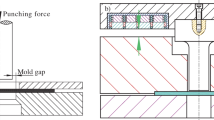Abstract
Through detecting method of pulsed eddy-current (PEC) and according to thickness testing model of multi-layer metal, infer the mathematical model of eddy current testing method in single-layer metal. Use Maxwell field equations to find solutions of vector magnetic potential in its boundary conditions thus infer the impedance of hollow coil placed right above metal. Analyze the variation relationship between induced current and metal thickness in theory level. (1) Obtain three characteristic signals of induced current: altitude of current peak value (ACPV), time of reaching current peak (TRCP) and time of traversing zero point (TTZP). The thickness of the metal and the distance between the metal and coil were obtained. (2) Introduce the concept of the lift-off intersection point (LOI) and puts forward a new method of metal thickness detection based on the LOI. By analyzing the results of the experiment, it confirms the feasibility of the LOI of measurement in the metal thickness.









Similar content being viewed by others
References
Fan, M., Cao, B., Sunny, A.I., et al.: Pulsed eddy current thickness measurement using phase features immune to liftoff effect. Ndt. E. Int. 86, 123–131 (2017)
Yoshioka, S., Gotoh, Y.: Proposal of thickness measurement method of steel plate with high lift-off using pulsed magnetic field. IEEE Trans. Mag. 53, 1–4 (2017)
Cheng, W.: Thickness measurement of metal plates using swept-frequency eddy current testing and impedance normalization. IEEE Sens. J. 17(14), 4558–4569 (2017)
Zheng, G., Xia, R., Chen, Y., et al.: Research on double coil pulse eddy current thickness measurement. In: Proceedings of the International Conference on Intelligent Computation Technology and Automation. pp. 406–409 (2017)
Azaman, K.N., Sophian, A., Nafiah, F.: Effects of coil diameter in thickness measurement using pulsed eddy current non-destructive testing. Mater. Sci. Eng. 260(1), 012001 (2017)
Fu, Y., Lei, M., Li, Z., et al.: Lift-off effect reduction based on the dynamic trajectories of the received-signal fast Fourier transform in pulsed eddy current testing. NDT E Int. 87, 85–92 (2017)
Fan, M., Cao, B., Tian, G., et al.: Thickness measurement using liftoff point of intersection in pulsed eddy current responses for elimination of liftoff effect. Sens. Actuators A 251, 66–74 (2016)
Li, W., Wang, H., Feng, Z.: Non-contact online thickness measurement system for metal films based on eddy current sensing with distance tracking technique. Rev. Sci. Instrum. 87(4), 045005 (2016)
Angani, C.S., Ramos, H.G., Ribeiro, A.L., et al.: Lift-off point of intersection feature in transient eddy-current oscillations method to detect thickness variation in stainless steel. IEEE Trans. Magn. 52(6), 1–8 (2016)
Angani, C.S., Ramos, H.G., Ribeiro, A.L., et al.: Evaluation of transient eddy current oscillations response for thickness measurement of stainless steel plate. Measurement 90(1), 59–63 (2016)
Li, J., Wu, X., Zhang, Q., et al.: Measurement of lift-off using the relative variation of magnetic flux in pulsed eddy current testing. NDT E Int. 75, 57–64 (2015)
Shokralla, S., Sullivan, S., Morelli, J., et al.: Modelling and validation of Eddy current response to changes in factors affecting pressure tube to calandria tube gap measurement. NDT E Int. 73, 15–21 (2015)
Yuedong, W.U., Huang, C., Xiong, B., et al.: Compensation method of sensor lift-off effect to thickness measurement of pulsed eddy current. Ship Electr. Eng., 2015
Angani, C.S., Ramos, H.G., Ribeiro, A.L., et al.: Transient eddy current oscillations method for the inspection of thickness change in stainless steel[J]. Sens. Actuators A 233, 217–223 (2015)
Huang, C., Wu, X.: Probe lift-off compensation method for pulsed eddy current thickness measurement. In: Proceedings of the International Conference on IEEE Antennas and Propagation. pp. 937–939 (2014)
Gang, Z., Ding, L., Zhen, Z., et al.: Research on thickness measurement based on lift-off intersection of pulsed eddy current. Chin. J. Sci. Instr. 29(8), 1745–1749 (2008)
Lefebvre, J.H.V.: Mandache C. Pulsed eddy current measurement of lift-off. In: Proceedings of the Review of Progress in Quantitative Nondestructive Evaluation. American Institute of Physics, pp. 669–676 (2006)
Luquire, J.W., Deeds, W.E., Dodd, C.V.: Alternating current distribution between planar conductors. J. Appl. Phys. 41(10), 3983–3991 (1970)
Cheng, C.C., Dodd, C.V., Deeds, W.E.: General analysis of probe coils near stratified conductors. Int. J. Nondestr. Test. 3, 109–130 (1971)
Deeds, W.E., Dodd, C.V.: Analytical solutions to eddy-current probe-coil problems. J. Appl. Phys. 39(6), 2829–2838 (1968)
Chen, X.: Time-domain analytic expressions for pulsed eddy current field of conductive plate and characteristic quantity for thickness measurement. Trans. China Electr. Soc. 28(7), 1–8 (2013)
Danon, Y., Lee, C., Mulligan, C., et al.: Characterizing tantalum sputtered coatings on steel by using eddy currents. IEEE Trans. Magn. 40(4), 1826–1832 (2004)
Tsuboi, H., Seshima, N., Sebestyen, I., et al.: Transient eddy current analysis of pulsed eddy current testing by finite element method. Magn. IEEE Trans. 40(2), 1330–1333 (2004)
Bowler, J., Johnson, M.: Pulsed eddy-current response to a conducting half-space. IEEE Trans. Magn. 33(3), 2258–2264 (1997)
Sophian, A., Gui, Y.T., Taylor, D., et al.: Design of a pulsed eddy current sensor for detection of defects in aircraft lap-joints[J]. Sens. Actuators A 101(1–2), 92–98 (2002)
Tai, C.C., Rose, J.H., Moulder, J.C.: Thickness and conductivity of metallic layers from pulsed eddy-current measurements. Rev. Sci. Instrum. 67(11), 3965–3972 (1996)
Acknowledgements
This work was financially supported by National Nature Science Foundation of China (Grant Nos. 51478383, 5120916, 51678470), National Program on Key Research SUB-Project (Grant No. 2017YFC0704207-03), Youth Science and Technology Project of Shaanxi Province (Grant No. 2016KJXX-64), Science and technology project of Xi’an (Grant No. JKDZ0011), Science and technology project of Xi’an BEI LIN (Grant No. GX1705).
Author information
Authors and Affiliations
Corresponding author
Rights and permissions
About this article
Cite this article
Zhao, L., Li, CJ., Duan, ZX. et al. The metal thickness detection using pulsed eddy-current computation and detection method. Cluster Comput 22 (Suppl 3), 6551–6562 (2019). https://doi.org/10.1007/s10586-018-2335-4
Received:
Revised:
Accepted:
Published:
Issue Date:
DOI: https://doi.org/10.1007/s10586-018-2335-4




